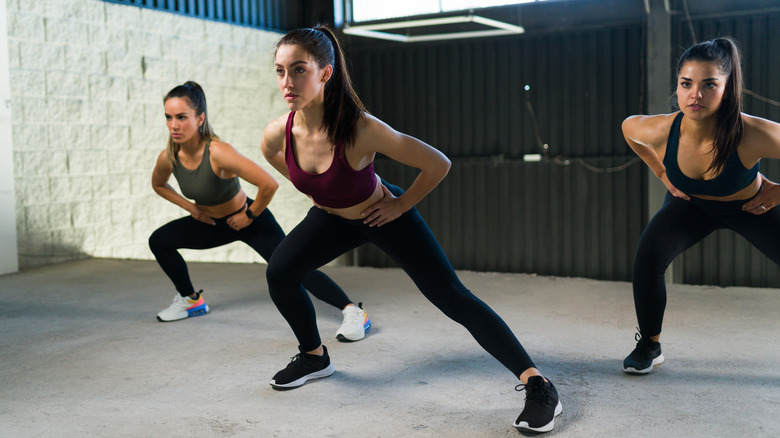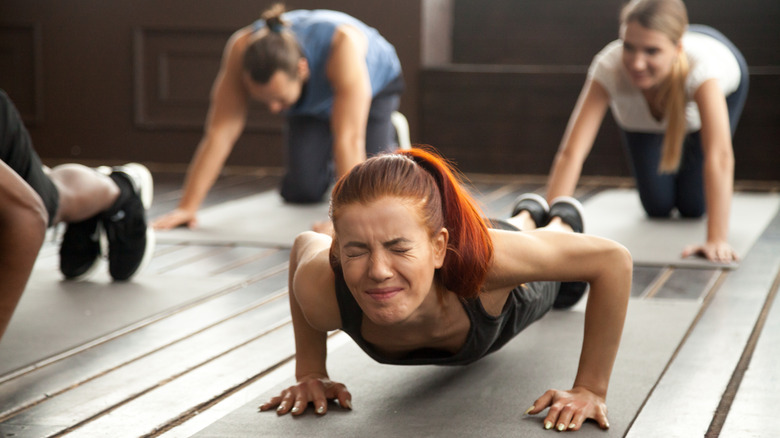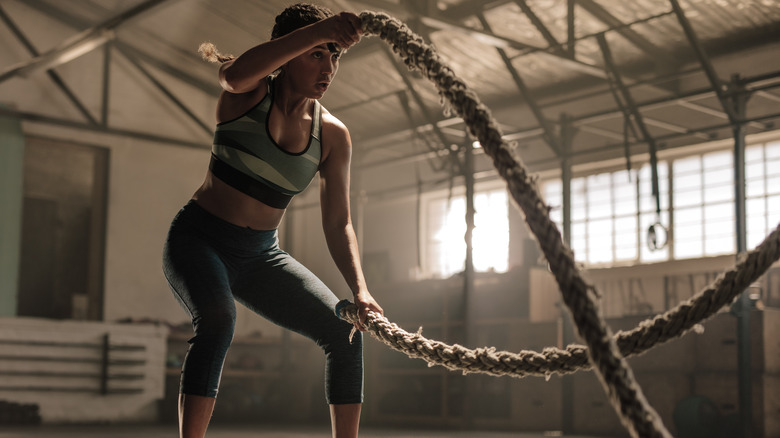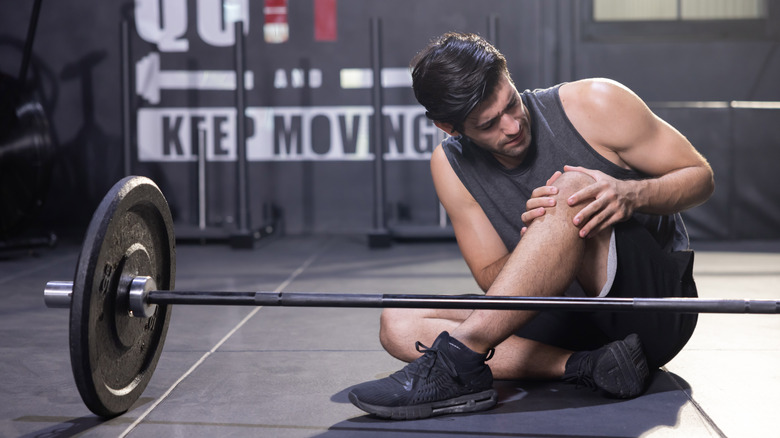Myths You Should Stop Believing About HIIT Workouts
High-intensity interval training, or HIIT, gets a lot of praise for its health and fitness benefits. Proponents say it burns fat, boosts aerobic endurance, and builds lean mass — among other perks. For example, the American Council on Exercise (ACE) states that HIIT can speed up your metabolism, improve lung health, and promote muscle growth. What's more, this training method increases excess post-exercise oxygen consumption (EPOC), causing your body to burn calories for hours after exercise.
But that's not all. A typical HIIT workout takes less than 30 minutes, meaning you don't have to spend hours in the gym to reap the benefits. Plus, it causes an increase in testosterone levels and other hormones that contribute to hypertrophy, or muscle building, notes ACE. In one study, hockey players who performed HIIT for four weeks experienced significant improvements in muscle thickness, power, speed, and endurance, reports the International Journal of Sports Medicine.
HIIT consists of short, intense bursts of exercise followed by recovery intervals, and can be used for both cardiovascular and strength training. ACE recommends no more than two HIIT workouts per week for up to six weeks, followed by a break. This form of exercise puts a lot of stress on the body, so it's best not to overdo it. Also, note that HIIT isn't a magic bullet for weight loss or better health. With that in mind, here are some common myths you may have heard about it — and the truth behind them.
Myth: HIIT is suitable for everyone
Despite its potential benefits, HIIT doesn't work for everyone. Chances are, you may not be able to do a HIIT workout if you're out of shape or just starting your fitness journey. During high-intensity intervals, you're supposed to work at up to 95% of your maximal aerobic capacity, or oxygen uptake, explains ACE. That means you'll run out of breath in no time, especially if you're new to exercise. "The price is 100% intensity. It's undeniable that the experience will be unpleasant," says Panteleimon Ekkekakis, a professor of kinesiology at Iowa State University.
Additionally, there are cases where HIIT can be dangerous. For example, older adults should consult their healthcare provider before jumping on the bandwagon, suggests Harvard Medical School. While it's true that HIIT may improve aerobic fitness and lower blood pressure, it may not be safe for people with heart issues.
You should also avoid this training method if you have an injury, as it could make things worse (per Livestrong). Alternatively, opt for HIIT exercises that put less stress on the injured area. If, say, you have knee or hip pain, forget about running, cycling, jumping, and other lower body exercises for a while. Instead, experiment with upper body HIIT workouts consisting of push-ups, dumbbell front raises, or triceps dips — just remember to keep the intensity high.
Myth: More is always better
As mentioned earlier, it's not recommended to do HIIT more than twice a week. Yet, Instagram and other online platforms feature gym-goers who perform this kind of workout daily or every other day — and that's a recipe for injury. "HIIT is very taxing on the body, hence the 'intensity' in the name," explained personal trainer Lee Jay in an interview with CNET. Like most types of exercise, this training method elevates levels of the stress hormone cortisol. If you go overboard, your cortisol levels will remain elevated, which may cause a host of issues.
HIIT also depletes your glycogen stores, leaving you tired and sluggish. If you keep pushing your limits, you'll have a hard time recovering from exercise and reaching your training goals. Excessive HIIT can also affect joint health, metabolism, sleep, and motivation, says Jay. Over time, it may lead to overuse injuries, such as tendonitis, warns the International Sports Sciences Association (ISSA).
Too much HIIT can also put you at risk for exertional rhabdomyolysis, a condition characterized by muscle breakdown, weakness, and pain, according to a 2017 case report published in Internal Medicine. Anyone can develop rhabdomyolysis following high-intensity exercise, reports the Military Health System. In severe cases, this disorder can lead to serious electrolyte imbalances or kidney failure. Given these risks, it makes sense to listen to your body and practice caution, especially when training for several days in a row. Most importantly, forget the old saying, "No pain, no gain."
Myth: HIIT can replace steady-state cardio
Tabata and other HIIT workouts are often used as a substitute for steady-state cardio. While both types of training can be effective, they're not the same. First of all, HIIT is a form of anaerobic exercise, whereas steady-state cardio, such as cycling at a moderate pace, is aerobic. "Anaerobic workouts primarily utilize fast twitch muscle fibers that can function only for a short amount of time without the help of additional inhaled oxygen," personal trainer Lesley Bell told Women's Health.
Cardiovascular training, on the other hand, involves continuous exercise, and focuses on oxygen. "Aerobic exercise is anything where oxygen intake is sufficient enough to provide the energy necessary to sustain that exercise without tapping into alternative energy sources," explains Andy Coggan, the director of fitness at Gold's Gym (via Women's Health). "Both styles of training will burn calories and improve the function of the heart and lungs, and the best bet for maximum adaptation and body transformation is to combine these training styles over the course of a week," he recommends.
All in all, HIIT and steady-state cardio aren't mutually exclusive. Even if you do HIIT, you can still benefit from aerobic training. Plus, both strategies are equally effective at improving conditioning in untrained individuals, according to clinical evidence published in the Journal of Sports Science and Medicine.
Myth: HIIT requires fancy equipment
Some athletes, especially CrossFitters, use fancy gear like slam balls, battle ropes, and air bikes for their HIIT sessions, but that doesn't mean you have to do the same. Contrary to popular belief, HIIT doesn't require a lot of equipment. In fact, you can stick to bodyweight exercises or use basic fitness accessories, such as dumbbells and medicine balls. For example, Muscle and Strength recommends a 20-minute bodyweight HIIT workout consisting of squats, burpees, high kicks, sit-ups, running in place, and other movements. Your training session could also include mountain climbers, high knees, jumping jacks, lunges, or push-ups.
The equipment used for HIIT workouts depends on your budget and how much space you have available. Resistance bands, jump ropes, Swiss balls, and parallel bars are all great choices. For core work, add an ab mat or ab wheel to the mix. Ab rollers, or ab wheels, cost less than $20 in most stores and can be used for knee tucks, planks, standing rollouts, single-arm rollouts, and more.
Speaking of core strength, fitness expert Yuri Elkaim recommends some simple yet effective HIIT core exercises that only require a Swiss ball. Prone ball twists, for instance, engage the obliques, hips, and lower back, leading to improved balance and stability. If you're a newbie, start with bicycles, crunches, and other basic exercises before progressing to more complex movements. Remember, the key is to keep the intensity up.
Myth: HIIT workouts pose a high risk of injury
You might have heard that HIIT is bad for your joints, causing all sorts of aches and injuries. As discussed earlier, this training method can indeed lead to injuries if you overdo it. However, performing HIIT workouts once or twice a week is likely safe as long as you maintain a good form. "When form is inconsistent, our joints may become misaligned which puts strain on the wrong parts of the body, leading to unwanted injuries," personal trainer Lee Jay told CNET. This goes for any type of exercise, including steady-state cardio.
HIIT is no more dangerous than American football, weight training, soccer, and other sports, explains Massachusetts General Hospital. Most injuries associated with HIIT workouts affect the shoulders, knees, lower back, elbows, and wrists, while rhabdomyolysis is very rare. While it's not possible to eliminate these risks, you can minimize them by watching your form and increasing workout intensity gradually over time.
For example, you may not be able to do standard push-ups for 30 seconds from day one, but you can start with wall push-ups or kneeling push-ups to build up your strength. As you progress, try more challenging exercises, such as clapping push-ups or diamond push-ups. Also, consider working with a personal trainer to learn proper exercise form before transitioning to high-intensity workouts.






